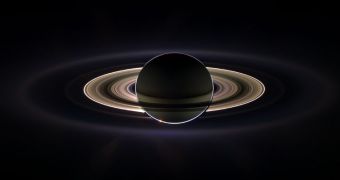Astronomers say that a large comet impacted Saturn's beautiful rings back in the 1300s. While this has been known for quite some time, a new study indicates that the tracks are still visible today. The announcement was made on October 4, at a science meeting.
Essam Marouf, who is a professor of electrical engineering at the San Jose State University, in California, as well as a member of the science team for the NASA Cassini orbiter, says that experts can still analyze the ripples left behind by the comet.
He made the announcement last Tuesday, at the joint meeting of the European Planetary Science Congress (EPSC) and the American Astronomical Society’s (AAS) Division for Planetary Sciences.
As the comet moved towards the gas giant, Saturn's massive gravitational pull disintegrated the frozen space rock into clouds of debris, which then zipped through its beautiful, thin dust and ice rings.
According to Marouf, Cassini is still able to detect traces of those ripples in the planet's C Ring, by using its radio science instruments. The expert says that his team found a “very unusual kind of addition” to the standard ring structure the scientists were expecting to see.
“There were highly regular little wiggles that rippled over hundreds of kilometers in a very specific pattern,” the investigator explains. The region contained a wave that repeated once every 1.2 kilometers, while the other repeated once every 1.3 kilometers (0.74 and 0.8 miles, respectively).
The research group was able to figure out the age of the impacts because they know how older ripples tend to cluster together, while their wavelengths shrink in a predictable manner. Thus, the team estimates the newly-found structures to be about 600 years old.
“They date back to about the late 1300s. And there is very clear evidence for two events, not one, separated by about 50 years,” Marouf told attendants at the conference, Science News reports.
“This is such an amazing result. Two events is really a hint that this is a cometary kind of thing. Some object got captured into orbit, made two close passages. Survived the first, not totally damaged – then 50 years later it came back in and that was the end of it,” Mark Showalter adds.
The investigator is based at the SETI Institute in Mountain View, California.

 14 DAY TRIAL //
14 DAY TRIAL //